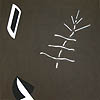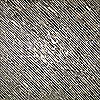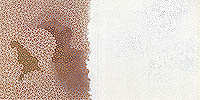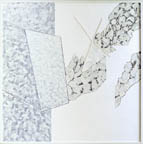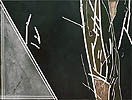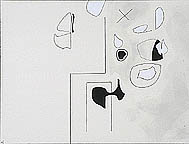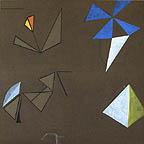| Contents | Other Articles | Work | Introduction | CV |
ART GALLERY OF PETERBOROUGH August 19 - October 2, 2005
CIMABUE'S GOLD
Catalogue Essay by I. M. Tamplin
|
Cimabue's Gold and Ron Bloore at 80
Bloore is well known for his carefully crafted white on white paintings. He has usually not given them titles, except for the most recent series of works. which he named the Dark Chocolate Series because the surfaces of the paintings are predominately dark brown, the colour of masonite. Before we take a closer look at this new work, it should be noted that Bloore has been painting with oil on masonite since the 1950s. All through his career, he has preferred a rigid surface to the more flexible one of a stretched canvas. Although masonite has been his chosen painting ground, Bloore until now has only intermittently given its surface such prominence.
In the current works, Bloore first makes a small pencil drawing to establish his compositional ideas. Then a chalk grid, later removed, is laid out on the masonite and the elements from the drawing are crafted in-oil on this ground. He builds up some of the forms with thick impastos much like the relief areas in the white on white paintings. To put the most recent Dark Chocolate Series into context I chose for this exhibition some examples of paintings on masonite since 1988 including works with Bloore's unique vocabulary of images which reveal many aspects of his process. There are stars, crosses, broken lines. circles and half circles, rays, nets, leaf forms and many other visual 'presences' that he has invented and carefully defined. For example, the painting Untitled: March 12 1988 is a monumental, upright composition superimposed with cross-shapes, rendered in several different whites. An unexpected exposed patch of masonite at the lower left comer of the work suggests a borderless space behind the painted forms. Terrence Heath, in the catalogue mentioned above, recognized that while Bloore establishes his usual codes in continuities and surface rendering, he also tends to break them by leaving areas of the raw masonite exposed. Untitled #III, a diptych from February 1988 is a mirror image composition of crosses with a flat framing device on only three sides. The composition rising from the bottom of the panels appears as though there may be more below the frame that is not visible. Similarly, the three panels from the Blue Series, 1998 drop the 'horizon' line to the very bottom edge of painting, but again it is not a real base line where the composition ends but more of a compositional device that suggests a continuity of forms which can be imagined in the space below the framing line. The crosshatched areas and translucent whites shimmer above the masonite ground, visually extending the imagery outward beyond the frame's perimeter.
In this brief overview, it is evident that the new Dark Chocolate Series has evolved out of Bloore's long working relationship with the material. However, there are at least three other factors about these works that I would like to address. The first is Bloore's special regard for the Spanish painter Joan Miró, the second is the concept of 'constellating' and the third is Cimabue's use of gold. Bloore once told me that when Miró came out of the hospital after an illness, he sent him a telegram that said simply "Bravo Miró. Earlier, Bloore had written: "The last great painter of the Western World was Cimabue... until Miró." (Heath in the 1993 Regina catalogue, pg.69). Before that, Miró had expressed the view that, "All art after neolithic art is decadent". What Miró and Bloore were referring to was the development of perspective during the Renaissance, which led to Illusionism in painting. Illusionism was seen as progressive by the generations of artists that followed until we come to the 20th century when artists began to recognize the merits of works from non-western cultures and like them, created artworks that were successful without Illusionism and hierarchical compositions. From the very beginning of his career, Bloore has admired and studied the art of other cultures and has organized his paintings in a non-hierarchical manner.
In several essays on Bloore's work. writers have likened his use of pictorial space to a kind of cosmic space. I also did this when I included his work in the 1982 exhibition L'Etoile Noire, named after a painting by Paul-Emile Borduas. Since then, I found a passage by the Spanish sculptor Julio Gonzalez that says; "In the unrest of the night the stars are to us points of hope in the skies. These points in infinity have been the forerunners of the new art: Signs in Space." (From the notes left by Julio Gonzalez) in Leon Degand, Gonzalez, 1959, Universe Sculpture Series. This passage is again referenced by Rosalind Krauss in The Originality of the Avant-Garde and Other Modernist Myths: first published in 1985. She notes that in 1932, Julio Gonzalez reflected on the ancient practice of configuring the constellations. Krauss says; "To draw with the stars is to constellate, which means to employ technique that is neither mimetic nor abstract." She then quotes the same passage by Gonzalez although the translation is a bit different: "In the restlessness of the night, the stars mark out points of hope in the sky .. . It is these points in the infinite which are the precursors of this new art: To draw in space."
As for Cimabue, he was an Italian painter (active c. 1272- 1302) who depicted his religious figures against a solid gold background as was customary in pre- Renaissance times. In 1980, Bloore gave a lecture about "Giotto's Error". Giotto, an Italian painter (active c. 1300- 1337) who was thought to be Cimabue's apprentice, also painted religious subjects, but according to Bloore, made the error of painting his sky blue and thus initiated Illusionism in painting. Terrence Heath saw Bloore's white on white paintings as a return to a kind of 'ground zero'. I see Bloore's most recent cycle of exposed masonite paintings as his true ground zero. At age 80 in this 21 st century, Bloore has found Cimabue's gold in the neutral expanse of the brown masonite surface where his scintillating iconic forms are given the space to 'constellate'. Illi-Maria Tamplin
[cf. also: |
| Top of Page | Contents | Other Articles | Work | CV |
